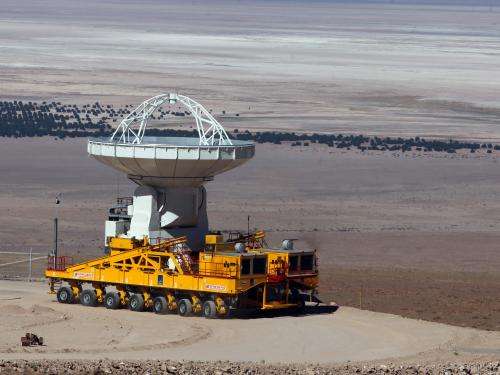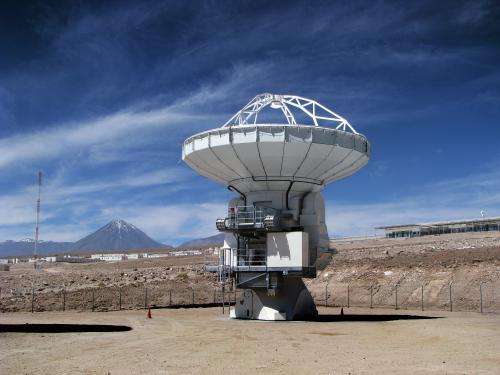Final North American ALMA antenna delivered

(Phys.org)—After an odyssey of design and construction stretching across more than a decade, North America has delivered the last of the 25, 12-meter-diameter dish antennas that comprise its share of antennas for the international ALMA telescope. This is an important milestone in the construction of an observatory that astronomers are already using to open up a "final frontier" of the spectrum of invisible light to high-resolution exploration.
ALMA, the Atacama Large Millimeter/submillimeter Array
, stretches across more than 75 square miles of a high-altitude desert plain in northern Chile. The scientific communities of North America, Europe, and East Asia have banded together to build the observatory, and are sharing its $1.3 billion cost. When completed, ALMA will have a total of 66 antennas, 25 from North America, 25 from Europe, and 16 from East Asia. "We are delighted to deliver this final ALMA antenna from North America," said Mark McKinnon, the North American

Faint radio waves, emitted naturally by gas and dust in space, will be detected and measured by the antennas, with the measurements then processed by a supercomputer to generate images as detailed as would come from a single dish that was miles across. These images will give astronomers insights into previously invisible or unresolved processes of planet, star, and galaxy evolution, both nearby and across cosmic time.
The technique of combining radio telescopes to form a virtual, high-resolution instrument has been in use for decades. For example, the National Science Foundation's (NSF's) recently revitalized Very Large Array (VLA) in New Mexico uses this technique to explore the Universe as seen in centimeter-wavelength light. ALMA is the first VLA-scale array to attempt this feat at millimeter and submillimeter wavelengths. For these shorter wavelengths, an antenna dish surface must be more precise, able to maintain its parabolic curvature to within the thickness of a human hair amidst harsh conditions at the 16,500-foot high ALMA site.
Funding to build the 25, 110-ton North American antennas was provided by the NSF, in the largest single procurement in the history of the foundation's astronomy division. Associated Universities, Inc. (AUI) managed the contract, while NRAO oversaw the integration and testing of the antennas, which were manufactured and assembled by General Dynamics SATCOM Technologies. Each antenna's pedestal and dish structure components were shipped separately to the ALMA site, and assembled in a huge hanger building, also built by General Dynamics.
Once ALMA is completed next year, it is expected to serve as a state-of-the-art radio telescope for thirty years or more.
"This is a very exciting time in astronomy," commented Tony Beasley, NRAO Director. "With ALMA we are taking perhaps the greatest leap in observing power in the history of the science."
Ethan Schreier, president of AUI, said "ALMA is the largest, most expensive ground-based astronomy project ever attempted, and a model for international science collaborations. The success of the partnership is manifest in the achievement of this milestone, but will be even more evident in the legacy of discovery and understanding that is going to emerge over the coming years, as tomorrow's eager astronomers get their hands on this fantastic telescope."
Provided by National Radio Astronomy Observatory



















